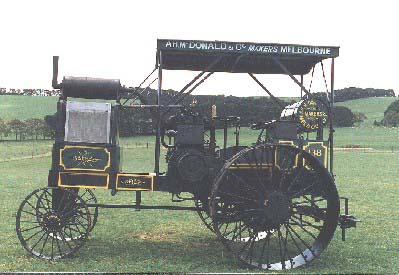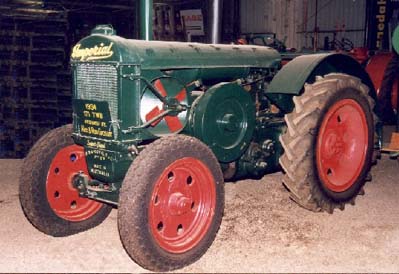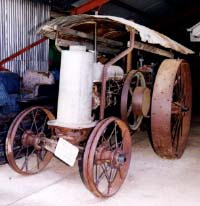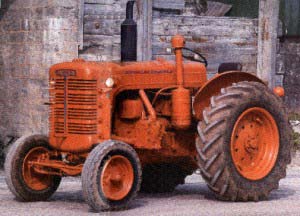A Brief History of Tractors in Australia by Bob Kavanagh After Captain Cook's exploration of the east coast in 1770 the British Government decided to establish a penal colony in Australia. The first fleet arrived in 1788 and consisted mainly of convicts who were poorly equipped and new little of farming techniques. The colony remained far from self-supporting and it was not until the early 1800's that things started to improve. Free settlers started to arrive, they followed the explorers across the mountains and where land was suitable set up farms. The gold-rushes of the 1850's brought wealth to the colonies and more than doubled the population, this increased the need for food and farming began to expand. The export of agricultural products to England on returning ships also increased.
The first steam engines were imported and used mainly in flourmills, the gold rush increased the demand for their use in water pumping and rock stamping. In the latter part of the 1800's Australian firms began to manufacture both portable and traction steam engines. It is believed that the first internal combustion engine tractor to be used in Australia was an Ivel from England in about 1903.
The Caldwell brothers started working on a four-wheel drive tractor around 1906, they later joined Henry Vale to form Caldwell-Vale Motors. Around 1910 they introduced what must have been one of the worlds first tractors with four-wheel drive and four wheel power steering. They also built trucks with the same configuration to haul road trains in the outback. A car with four-wheel drive, four-wheel power steering was also produced. Due to financial reasons and a law suit the innovative company was taken over and production of these advanced tractors ceased around 1916.
As stated above H V McKays first claim to fame was the Stripper-Harvester, the demand for this machine grew and by 1915 they had sold thousands of them overseas. Around 1913 the company produced a Header-Harvester designed by H S Taylor, a few years later they made their first tractors. They produced a model A and a more streamlined model O, production continued until the mid 1920's. In the 1930's they sold the Massey Harris Model 25, Pacemaker and the Challenger tractors. H V McKay became one of Australia's largest agricultural machinery manufacturers and in the 1950's became part of Massey Ferguson Ronaldson Bros. & Tippett partnership began producing agricultural machinery in the early 1900's and was one of the earliest Australian companies to design and make internal combustion engines (Austral). They built a prototype tractor in 1910 but it was not until 1924 that they introduced their Super Drive. The first tractors were basically American "Illinois 18-30" with Wisconsin engines and larger radiators for the hot Australian conditions. Eventually most of the tractor was built in their Ballarat factory, they continued to produce tractors until the late 1930's. The company manufactured Wisconsin engines under license until 1972. Another great Australian agricultural engineer was Cliff Howard, he was only 16 when he built his first rotary powered by a motor cycle engine in 1912. It was around 1921 before he could afford to set up a company to manufacture some of his inventions. By the mid 1920's he had sold several of his tractor rotary hoe combinations. He then made a rotary hoe attachment for the very popular Fordson tractor until they ceased production in 1928. During this time they had also been making smaller self propelled walk behind rotary hoes and some three wheeled tractor/rotary hoes. The DH22 tractor was released in 1930, a Howard 22hp engine was also developed for this tractor. Some 4WD TUG's were also made for railway work. Cliff Howard spent many years in England developing Rotary Hoe Cultivators Ltd., after WW2 this company sold into the North American market. He was also involved with the Platypus crawler tractor. He returned to Australia in the late 1950's and regained control of Howard Australia. They produced small garden tractors, the Kelpie in about 1945 and the Howard 2000 in 1962. The Howard Company still exists under a different structure and manufactures rotary hoe tractor attachments.
Kelly & Lewis who go back to the early 1900's made the KL Bulldog. They were mainly involved with engines and in the 1930's became the agent for Lanz Bulldog. Due to the war production of these German tractors ceased and Kelly & Lewis decided to make their own version of the 40hp Bulldog. The first bulldogs came out of their Springvale factory in 1949 and continued until about 1954. By this time the German company began to produce improved versions of the tractor and K & L found it hard to sell their stock, a total of about 900 were made. J Deere took a controlling interest of Lanz in 1956. Big Lizzie, was a one-of 40-ton monster built by Frank Bottrill in 1915-16. Earlier he had developed his "Dreadnaugh Wheels" which he fitted to other large tractors. These of course were fitted to his 34 foot long Big Lizzie. He worked the tractor till the mid 1920's, by this time crawler tractors became far more efficient. It is on display at Red Cliffs, Victoria International Harvester set up a factory in Geelong in the late 1930's but it was not until 1949 that the first tractor the AW-6 came off the production line. Production of Australian models continued for the next thirty years, in the 1980's some American models were assembled in the factory. In 1986 when Case and IH merged production at the Geelong plant ceased. Two other tractors, Australian in name only were the "Vickers Aussie" released in 1925, it was actually made in England and based on the McCormick-Deering 15-30 and also in the 1920's the "Hart-Parr Australian Special" from Iowa, USA. In the 1980's several large purpose built tractors were designed and built in Australia they included, Acremaster, Baldwin, Phillips, Upton, Waltanna etc. For more info on tractors down under, The Aussie Tractor Page. www.ozemail.com.au/~bobkav
We sell tractor parts! We have the parts you need to repair your tractor - the right parts. Our low prices and years of research make us your best choice when you need parts. Shop Online Today. Copyright © 1997-2024 Yesterday's Tractor Co. All Rights Reserved. Reproduction of any part of this website, including design and content, without written permission is strictly prohibited. Trade Marks and Trade Names contained and used in this Website are those of others, and are used in this Website in a descriptive sense to refer to the products of others. Use of this Web site constitutes acceptance of our User Agreement and Privacy Policy TRADEMARK DISCLAIMER: Tradenames and Trademarks referred to within Yesterday's Tractor Co. products and within the Yesterday's Tractor Co. websites are the property of their respective trademark holders. None of these trademark holders are affiliated with Yesterday's Tractor Co., our products, or our website nor are we sponsored by them. John Deere and its logos are the registered trademarks of the John Deere Corporation. Agco, Agco Allis, White, Massey Ferguson and their logos are the registered trademarks of AGCO Corporation. Case, Case-IH, Farmall, International Harvester, New Holland and their logos are registered trademarks of CNH Global N.V.
Yesterday's Tractors - Antique Tractor Headquarters |





